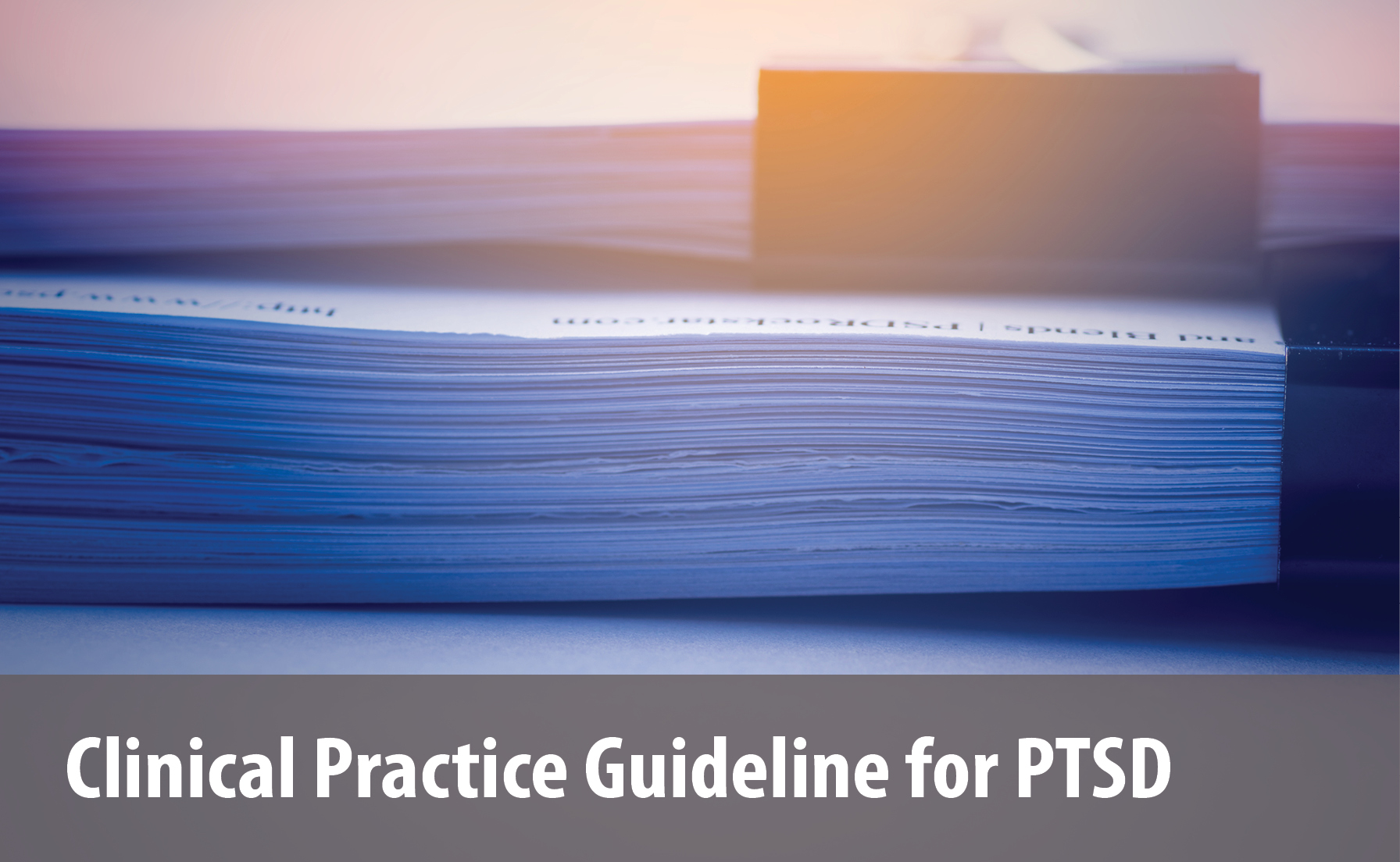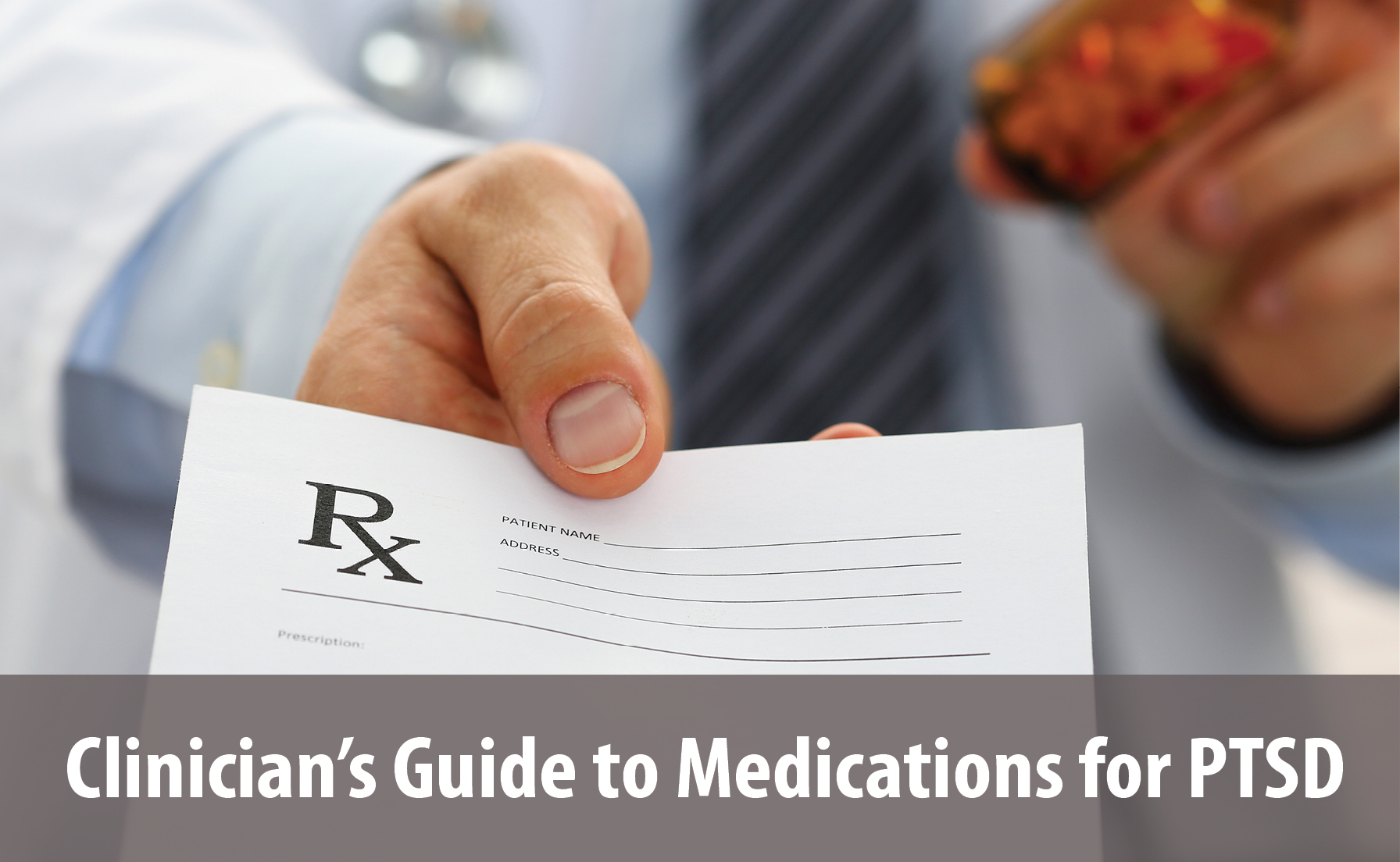PTSD: National Center for PTSD
Use of Benzodiazepines for PTSD in Veterans Affairs
Use of Benzodiazepines for PTSD in Veterans Affairs
Nancy Bernardy, PhD and Macgregor Montaño, PharmD
Key Points
- The 2023 VA/DoD Clinical Practice Guideline for PTSD recommends against the use of benzodiazepines for treatment of PTSD (1).
- Harms associated with chronic benzodiazepine use in patients with PTSD include substance use disorder (SUD), decreased effectiveness of recommended PTSD treatments, and cognitive dysfunction, particularly in older adults.
- Prescriptions for benzodiazepines for Veterans Health Administration (VHA) PTSD patients have decreased from 30% in fiscal year 2012 (FY12) to 7.0% in FY22 (Quarter 4; 2).
- The success seen in this reduction of use is primarily due to efforts of two VHA initiatives, the Psychotropic Drug Safety Initiative (PDSI) and the National Academic Detailing Program.
Evidence on the Use of Benzodiazepines for PTSD
The VA/DoD 2023 Practice Guideline for the Management of PTSD strongly recommends against the routine use of benzodiazepines in Veterans with PTSD (1). The recommendation was based on a lack of efficacy data for benzodiazepines to treat PTSD symptoms and well-known risks for misuse, negative effects on cognition, and potential to decrease effectiveness of recommended PTSD psychotherapies (3,4).
For instance, a systematic review of placebo-controlled trials found no evidence of benefit for benzodiazepines in PTSD (3). A meta-analysis of 18 controlled or observational studies (over 5,200 participants) found benzodiazepines to be ineffective for PTSD treatment and concluded the risks associated with their use outweigh potential short-term benefits (4). Additional prospective studies are unlikely since the established harms of benzodiazepines (see next section) are in conflict with the ethical conduct of research.
The proportion of Veterans with PTSD prescribed benzodiazepines in VA declined from 31.3% in 2009 to 10.7% in 2019, with a marked decrease after 2013, when VA initiatives (described below) began, emphasizing safety and efficacy in use of benzodiazepines (5). In the same period, the number of new prescriptions for benzodiazepines fell from 11.4% to 2.9% and the daily dose prescribed dropped 30% in Veterans with PTSD. Decreased prevalence was driven primarily by less use in Veterans newly diagnosed with PTSD (42.2%), followed by Veterans known to have PTSD (36.8%), and discontinuation among Veterans with PTSD already prescribed a benzodiazepine (21.0%; 5). A more recent study found similar declines, with the number of prescriptions for benzodiazepines among Veterans with PTSD decreasing from 27.4% in 2012 to 7.6% in 2022 (6). The number of new prescriptions during this time fell from 6.6% to 1.9% (6).
Despite these overall decreases in prescriptions, VA clinicians continue to prescribe benzodiazepines to PTSD patients who may be seen as high risk—such as Veterans 65 years of age and older, in whom benzodiazepine prevalence increased in VA from 14.5% in 2009 to 46.5% in 2019 (5). Women Veterans with PTSD are also more likely to be prescribed benzodiazepines than men (5). However, new prescriptions for benzodiazepines include fewer days’ supply and decreased subsequent fillings from 2012 to 2022, illustrating that the amount and length of benzodiazepine therapy are declining along with general use (6).
Problems Associated with Long-Term Benzodiazepine Use
Unfortunately, any short-term relief of anxiety from benzodiazepines rapidly dissipates, leaving a patient to continue taking the medication to avoid withdrawal and rebound effects (7). The common practice of allowing patients to take benzodiazepines on an as-needed basis can lead to fluctuating blood levels that can worsen anxiety and cognitive impairment (8). Regardless of diagnosis, there is a large literature documenting the harms of long-term benzodiazepine use (defined as > 3 months). This is especially true for older patients taking benzodiazepines, who are 2 to 3 times more likely to fall (9) and have 50% higher risk of hip fractures, even at modest doses with short-acting agents and short-term exposures (10,11). Cognitive dysfunction (including feelings of fogginess and confusion) is a common effect of long-term benzodiazepine use (12). Older patients taking benzodiazepines are also at increased risk for motor vehicle crashes (13,14). Chronic benzodiazepine use can also cause anterograde amnesia (15) and is associated with elevated risk of dementia and Alzheimer’s disease (16,17). Importantly, there is a 50% increase in overall mortality rates associated with long-term benzodiazepine use (18).
There are also PTSD-specific problems. The cognitive effects of long-term benzodiazepine use among Veterans with PTSD are particularly concerning. PTSD itself is a risk factor for dementia, with older Veterans with PTSD nearly twice as likely as Veterans without PTSD to develop dementia (19). Increased disinhibition among those Veterans who are already high in aggression is another important concern. Increases in aggressive behavior were found among Veterans with PTSD receiving benzodiazepines who were aggressive prior to treatment (see citation; 20). Benzodiazepines are also contraindicated in obstructive sleep apnea and chronic obstructive pulmonary disease (21), disorders commonly observed in Veterans with PTSD (22-24).
The long-recognized risks of misuse and dependence associated with use of benzodiazepines have particular relevance for Veterans with PTSD, who often have a co-occurring SUD. Pre-existing diagnosis of SUD may increase the risk of being prescribed high daily benzodiazepine doses for extended periods of time (25). Veterans who are on concurrent opioids and benzodiazepines are at increased risk for adverse effects including death from drug overdose (26,27).
Studies are mixed on whether benzodiazepines interfere with evidence-based cognitive-behavioral therapies (CBT) for PTSD, especially exposure-based therapies (28-30). There is some evidence that daytime dosing and long-acting benzodiazepines appear to interfere with the mental processes necessary to benefit from psychotherapy (4). For providers considering evidence-based psychotherapies (EBPs) for PTSD, they can discuss with patients whether they are willing to discontinue benzodiazepines for the reasons mentioned above. However, it likely does not make sense to require discontinuation of benzodiazepines in order to participate in an EBP given the limited and mixed evidence for how they impact each other.
Safe and Effective Treatment Options
The VA/DoD Clinical Practice Guideline recommends individual trauma-focused psychotherapies for PTSD, specifically Prolonged Exposure, Cognitive Processing Therapy, and Eye Movement Desensitization and Reprocessing (1). If these psychotherapies are not available or not preferred, recommended medications for PTSD include antidepressants such as sertraline (Zoloft), paroxetine (Paxil), and venlafaxine (Effexor; 1). Safer and more effective treatment options exist for the specific symptoms often targeted by clinicians with benzodiazepines (31).
Steps taken by VA to improve prescribing practices
The Psychotropic Drug Safety Initiative (PDSI) is a nationwide psychopharmacology quality improvement program launched in 2013. The program supports regional and medical center psychopharmacology quality improvement initiatives by data sharing, patient-level consultation and prescribing support, and educational opportunities through learning collaboratives and resources. One of the prescribing measures addressed in the program is use of benzodiazepines in patients with PTSD. There are also measures addressing use of benzodiazepines in older Veterans, regardless of PTSD diagnosis.
As a result of efforts taken by VA, FY22 data from the Psychotropic Drug Safety Initiative indicate the overall percentage of Veterans with PTSD who received an outpatient benzodiazepine prescription was at 7.0% (2). Given the lack of efficacy of benzodiazepines for the treatment of PTSD and the potential harms noted above, VA pharmacotherapy safety initiatives have identified potential subgroups of patients that are most at risk of adverse effects from long-term benzodiazepine use. These subgroups include patients with co-occurring traumatic brain injury (TBI) and co-occurring current or lifetime substance use disorder (SUD). Other high-risk groups include older Veterans and those with a history of chronic pain who are on other sedatives (32).
The Opioid Safety Initiative, established in 2012, has worked to support clinicians to reduce the use of opioids for chronic pain and offer safer, alternative treatment options. Co-prescribing of opioids and benzodiazepines has been a specific focus of these efforts because of the increased risk of overdose when these medications are taken together. As a result, VA data from FY12 to FY20 show a 56% decrease in the number of Veterans receiving opioids and an 83% decrease in the number of Veterans receiving a co-prescription of opioids and benzodiazepines (33).
The National Academic Detailing Service, developed through VA’s Pharmacy Benefits Management, has also focused on benzodiazepine use in patients with PTSD. The Academic Detailing program works by having clinical pharmacists meet with individual clinicians to review caseloads and suggest options for specific patients. Suggestions may include safe tapering strategy guidance as well as information on recommended alternative treatment strategies. PTSD-specific clinician dashboards and patient reports provide clinicians the ability to conduct proactive, population level management of specific classes of pharmacotherapy for their patients with PTSD.
Due to the significant risks associated with benzodiazepines and the lack of evidence for their effectiveness in the treatment of PTSD, it is worthwhile to implement strategies to carefully assess and consider alternate treatment options and to minimize new benzodiazepine prescriptions whenever possible. Although this can be clinically challenging and time-consuming, strategies to taper existing benzodiazepine prescriptions are effective (34-38). Ultimately, the results of VA’s efforts should result in continued decreases in utilization of these potentially harmful medications and facilitate effective treatment options among Veterans with PTSD who use VA care.
Printable Booklet
Benzodiazepines and PTSD: Do you know about this risky combination?
Download the PDF booklet to share with patients. It promotes shared decision-making by increasing knowledge for the risks of chronic benzodiazepine use in those with PTSD. It is based upon the original EMPOWER trial that was significantly effective in reducing benzodiazepine use in elderly adults (38).
References
- U.S. Department of Veterans Affairs and Department of Defense. (2023). VA/DoD Clinical Practice Guideline for Management of Post-Traumatic Stress Disorder and Acute Stress Disorder. Author. https://www.healthquality.va.gov/guidelines/mh/ptsd/
- U.S. Department of Veterans Affairs. (2024). Mental Health Information System: Psychotropic Drug Safety Initiative Dashboard. [Data set]. Program Evaluation and Research Center.
- Williams, T., Phillips, N. J., Stein, D. J., & Ipser, J. C. (2022). Pharmacotherapy for post traumatic stress disorder (PTSD). The Cochrane Database of Systematic Reviews, 3(3), CD002795. https://doi.org/10.1002/14651858.CD002795.pub3
- Guina, J., Rossetter, S. R., De, Rhodes, B., Nahhas, R., & Welton, R. S (2015). Benzodiazepines for PTSD: A systematic review and meta-analysis. Journal of Psychiatric Practice, 21(4), 281-303. https://doi.org/10.1097/PRA.0000000000000091
- Bernardy, N. C., Friedman, M. J., & Lund, B. C. (2022). Deimplementation of benzodiazepine prescribing in posttraumatic stress disorder in the Veterans Health Administration. The Journal of Clinical Psychiatry, 83(3), 21m14128. https://doi.org/10.4088/JCP.21m14128
- Shahid, K. N., Hadlandsmyth, K., Brainerd, D. R., & Lund, B. C. (2024). Characteristics of incident benzodiazepine recipients among US Veterans with posttraumatic stress disorder. American Journal of Health-System Pharmacy, 82(3), e166-e172. https://doi.org/10.1093/ajhp/zxae311
- Lader, M. (2011). Benzodiazepines revisited—will we ever learn? Addiction, 106(12), 2086-2109. https://doi.org/10.1111/j.1360-0443.2011.03563.x
- Cloos, J. (2010, July). Benzodiazepines and addiction: Myths and realities (Part 1). Psychiatric Times, 27(7), 26-29. Retrieved May 1, 2020 from https://www.researchgate.net/publication/287365647
- Glass, J., Lanctôt, K. L., Herrmann, N., Sproule, B. A., & Busto, U. E. (2005). Sedative hypnotics in older people with insomnia: Meta-analysis of risks and benefits. BMJ, 331(7526), 1169. https://doi.org/10.1136/bmj.38623.768588.47
- Wang, P. S., Bohn, R. L., Glynn, R. J., Mogun, H. & Avorn, J. (2001). Hazardous benzodiazepine regimens in the elderly: Effects of half-life, dosage, and duration on risk of hip fracture. American Journal of Psychiatry, 158(6), 892-898. https://doi.org/10.1176/appi.ajp.158.6.892
- Chang, C. M., Wu, E. C., Chang, I. S., & Lin, K. M. (2008). Benzodiazepine and risk of hip fractures in older people: A nested case-control study in Taiwan. American Journal of Geriatric Psychiatry, 16(8), 686-692. https://doi.org/10.1097/JGP.0b013e31817c6a99
- Stewart, S. A. (2005). The effects of benzodiazepines on cognition. Journal of Clinical Psychiatry, 66 (Suppl 2), 9-13. Retrieved from http://www.psychiatrist.com/jcp
- Ray, W. A., Fought, R. L., & Decker, M. D. (1992). Psychoactive drugs and the risk of injurious motor vehicle crashes in elderly drivers. American Journal of Epidemiology, 136(7), 873-883. https://doi.org/10.1093/aje/136.7.873
- Hemmelgarn, B., Suissa, S., Huang, A., Boivin, J. F., & Pinard, G. (1997). Benzodiazepine use and the risk of motor vehicle crash in the elderly. JAMA, 278(1), 27-31. https://doi.org/10.1001/jama.1997.03550010041037
- Curran, H. V. (1991). Benzodiazepines, memory and mood: A review. Psychopharmacology, 105(1), 1-8. https://doi.org/10.1007/BF02316856
- de Gage, B. S., Bègaud, B., Bazin, F., Verdoux, H., Dartigues, J. F., Pèrés, K., Kurth, T., & Pariente, A. (2012). Benzodiazepine use and risk of dementia: A prospective population based study. BMJ, 345, e6231. https://doi.org/10.1136/bmj.e6231
- de Gage, S. B., Moride, Y., Ducruet, T., Kurth, T., Verdoux, H., Tournier, M., Pariente, A., & Bègaud, B (2014). Benzodiazepine use and risk of Alzheimer’s disease: Case-control study. BMJ, 349, g5205. https://doi.org/10.1136/bmj.g5205
- Kripke, D. F., Langer, R. D., & Kline, L. E. (2012). Hypnotics' association with mortality or cancer: A matched cohort study. BMJ Open, 2(1), e000850. https://doi.org/10.1136/bmjopen-2012-000850
- Yaffe, K., Vittinghoff, E., Lindquist, K., Barnes, D., Covinsky, K. E., Neylan, T., Kluse, M., & Marmar, C. (2010). Posttraumatic stress disorder and risk of dementia among US Veterans. Archives of General Psychiatry, 67(6), 609-613. https://doi.org/10.1001/archgenpsychiatry.2010.61
- Shin, H. J., Rosen, C. S., Greenbaum, M. A., & Jain, S. (2012). Longitudinal correlates of aggressive behavior in help-seeking U.S. Veterans with PTSD. Journal of Traumatic Stress, 25(6), 649-656. https://doi.org/10.1002/jts.21761
- Mazza, M., Losurdo, A., Testani, E., Marano, G., Di Nicola, M., Dittoni, S., Gnoni, V., Di Blasi, C., Giannontoni, N. M., Lapenta, L., Brunetti, V., Bria, P., Janiri, L., Mazza, S., & Marca, G. D. (2014). Polysomnographic findings in a cohort of chronic insomnia patients with benzodiazepine abuse. Journal of Clinical Sleep Medicine, 10(1), 35. https://doi.org/10.5664/jcsm.3354
- Hawkins, E. J., Malte, C. A., Grossbard, J. R., & Saxon, A. J. (2015). Prevalence and trends of concurrent opioid analgesic and benzodiazepine use among Veterans Affairs patients with post-traumatic stress disorder, 2003-2011. Pain Medicine. 16(10), 1943-1954. https://doi.org/10.1111/pme.12787
- Spitzer, C., Koch, B., Grabe, H. J., Ewert, R., Barnow, S., Felix, S. B., Ittermann, T., Obst, A., Völzke, H., Gläser, S., & Schäper. (2011). Association of airflow limitation with trauma exposure and post-traumatic stress disorder. The European Respiratory Journal, 37(5), 1068-1075. https://doi.org/10.1183/09031936.00028010
- Williams, S. G., Collen, J., Orr, N., Holley, A. B., & Lettieri, C. J. (2015). Sleep disorders in combat-related PTSD. Sleep and Breathing, 19(1), 175-182. https://doi.org/10.1007/s11325-014-0984-y
- Hermos, J. A., Young, M. M., Lawler, E. V., Rosenbloom, D., & Fiore, L. D. (2007). Long-term, high-dose benzodiazepine prescriptions in Veteran patients with PTSD: Influence of preexisting alcoholism and drug-abuse diagnoses. Journal of Traumatic Stress, 20(5), 909-914. https://doi.org/10.1002/jts.20254
- Park, T. W., Saitz, R., Ganoczy, D., Ilgen, M. A., & Bohnert, A. S (2015). Benzodiazepine prescribing patterns and deaths from drug overdose among US veterans receiving opioid analgesics: Case-cohort study. BMJ, 350, h2698. https://doi.org/10.1136/bmj.h2698
- Hawkins, E. J., Malte, C. A., Grossbard, J., Saxon, A. J., Imel, Z. E., & Kivlahan, D. R (2013). Comparative safety of benzodiazepines and opioids among Veterans Affairs patients with posttraumatic stress disorder. Journal of Addiction Medicine, 7(5), 354-362. https://doi.org/10.1097/ADM.0b013e31829e3957
- van Minnen, A., & Hagenaars, M. (2002). Fear activation and habituation patterns as early process predictors of response to prolonged exposure treatment in PTSD. Journal of Traumatic Stress, 15(5), 359-367. https://doi.org/10.1023/A:1020177023209
- Rosen, C. S., Greenbaum, M. A., Schnurr, P. P., Holmes, T. H., & Brennan, P. L (2013). Do benzodiazepines reduce the effectiveness of exposure therapy for posttraumatic stress disorder? Journal of Clinical Psychiatry, 74(12), 1241-1248. https://doi.org/10.4088/JCP.13m08592
- Rothbaum, B. O., Price, M., Jovanovic, T., Norrholm, S. D., Gerardi, M., Dunlop, B., Davis, M., Bradley, B., Duncan, E. J., Rizzo, A., & Ressler, K. J (2014). A randomized, double-blind evaluation of D-cycloserine or alprazolam combined with virtual reality exposure therapy for posttraumatic stress disorder in Iraq and Afghanistan War Veterans. American Journal of Psychiatry, 171(6), 640-648. https://doi.org/10.1176/appi.ajp.2014.13121625
- Bernardy, N. C., & Friedman, M. J. (2015). Psychopharmacological strategies in the management of posttraumatic stress disorder (PTSD): What have we learned? Current Psychiatry Reports, 17(4), 564. https://doi.org/10.1007/s11920-015-0564-2
- Bernardy, N. C., Lund, B. C., Alexander, B., & Friedman, M. J. (2014). Increased polysedative use in veterans with posttraumatic stress disorder. Pain Medicine, 15(7), 1083-1090. https://doi.org/10.1111/pme.12321
- Sandbrink, F., Oliva, E. M., McMullen, T. L., Aylor, A. R., Harvey, M. A., Christopher, M. L., Cunningham, F., Minegishi, T., Emmendorfer, T., & Perry, J. M. (2020). Opioid prescribing and opioid risk mitigation strategies in the Veterans Health Administration. Journal of General Internal Medicine, 35(3), 927-934. https://doi.org/10.1007/s11606-020-06258-3
- Morin, C. M., Bastien, C., Guay, B., Radouco-Thomas, M., Leblanc, J., & Vallières, A. (2014). Randomized clinical trial of supervised tapering and cognitive behavior therapy to facilitate benzodiazepine discontinuation in older adults with chronic insomnia. American Journal of Psychiatry, 161(2), 332-342. https://doi.org/10.1176/appi.ajp.161.2.332
- Tannenbaum, C. (2015). Inappropriate benzodiazepine use in elderly patients and its reduction. Journal of Psychiatry & Neuroscience, 40(3), E27-28. https://doi.org/10.1503/jpn.140355
- Pollmann, A. S., Murphy, A. L., Bergman, J. C., & Gardner, D. M. (2015). Deprescribing benzodiazepines and Z-drugs in community-dwelling adults: A scoping review. BMC Pharmacology and Toxicology, 16(1), 19. https://doi.org/10.1186/s40360-015-0019-8
- Vicens, C., Bejarano, F., Sempere, E., Mateu, C., Fiol, F., Socias, I., Aragonés, E., Palop, V., Beltran, J. L., Piñol, J. L., Lera, G., Folch, S., Mengual, M., Basora, J., Esteva, M., Llobera, J., Roca, M., Gili, M., & Leiva, At. (2014). Comparative efficacy of two interventions to discontinue long-term benzodiazepine use: Cluster randomized controlled trial in primary care. The British Journal of Psychiatry, 204(6), 471-479. https://doi.org/10.1192/bjp.bp.113.134650
- Tannenbaum, C., Martin, P., Tamblyn, R., Benedetti, A., & Ahmed, S (2014). Reduction of inappropriate benzodiazepine prescriptions among older adults through direct patient education: The EMPOWER cluster randomized trial. JAMA Internal Medicine, 174(6), 890-898. https://doi.org/10.1001/jamainternmed.2014.949
You May Also Be Interested In

VA/DoD Clinical Practice Guideline for PTSD (2023)
Get information on evidence-based treatment recommendations for PTSD.

Clinician's Guide to Medications for PTSD
Get key information and guidance on the best medications for PTSD.

























